Sharada Peeth
| Sharada Peeth | |
|---|---|
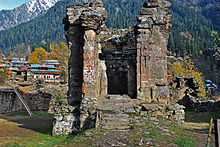 Ruins of the Sharada Peeth | |
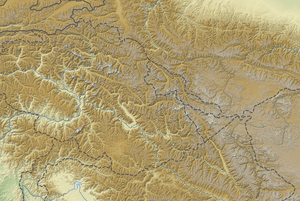 Sharada Peeth Location in India | |
| Name | |
| Devanagari | शारदा पीठम् |
| Sanskrit transliteration | Śāradā pīṭham |
| Bengali | শারদা পীঠ |
| Geography | |
| Coordinates | 34°47′35″N 74°11′19″E / 34.79306°N 74.18861°ECoordinates: 34°47′35″N 74°11′19″E / 34.79306°N 74.18861°E |
| Location | Sharda in PoK |
| Culture | |
| Primary deity | Sharada (Saraswati) |
Sharada Peeth (Urdu: شاردا پیٹھ), located near Sharda in Pakistan Occupied Kashmir, at the de facto border of India and Pakistan (Line of Control) (LOC), was the famous temple of the goddess Sarasvatī (Sharda) on the banks of Neelum River in PoK.[1] Its ruins are near the Line of Control (LOC)[1] between the Indian and Pakistani-controlled portions of the former princely state of Kashmir and Jammu. Shina, Pahari, and Kashmiri languages are mostly spoken in the area. Kashmir was a high established centre of learning of vedantic works until Muslim invaders from central-Asian countries destroyed it. Indegenious script of Kashmir is named after the deity Sharada Devi.[2] Kashmir was sometimes called Sharada Desh because of this temple and Sharada was called Kashmira Puravasini (resident of city of Kashmir).The Kashmiris are highly devoted towards this great deity[1] addressed as Bhagavathy. During their daily worship they often say "Namastey Sharada Devi Kashmir Pur Vasini Tvam Ham Prartheye Nityam Vidya Danam Che De hi mey" meaning Salutations to you, O Sharada, O Goddess, O one who resides in Kashmir. I pray to you daily, please give me the charity of knowledge."
The temple was last repaired by Maharaja Gulab Singh of Kashmir.[3][4][5]
The temple as a Shakti Peeth
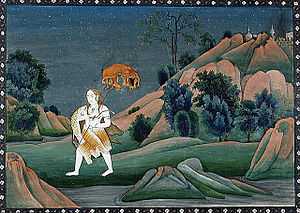
Shakti Peethas are shrines or divine places of Shakti formed due to the falling of body parts of the corpse of Sati Devi, when Shiva carried it and wandered throughout Aryavartha in sorrow. There are 51 Shakti Peeth linking to the 51 alphabets in Sanskrit. Each temple has shrines for Shakti and Kalabhairava. Sharada Peeth is one of the 18 Maha Shakti Peetha. Devi's Right hand is said to have fallen here. The Shakti worshiped here is the goddess of knowledge and education, Saraswathi otherwise known as Sarada. The mythology of Daksha yaga and Sati's self immolation had immense significance in shaping the ancient Sanskrit literature and even had cultural impact in India during olden times. It led to the development of the concept of Shakti Peethas and there by strengthening Shaktism. Enormous mythological stories in puranas took the Daksha yaga as the reason for its origin. It is an important incident in Shaivism and Shaktism.[6][7][8]
Location
The temple is located in a village called Sharda, in Neelam Valley, at a distance of 60 miles from Baramulla and about 16 miles from line of control.[9]
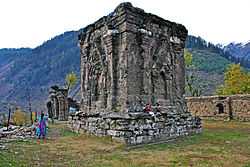
Place of learning
The place was once a celebrated centre of learning in the subcontinent.[2] It was a centre of great Sanskrit scholars and Kashmiri Pandits and was a famous centre of Hinduism and Buddhism. According to the Prabhāvakacarita, a Jain historical work dated 1277–78, the Śvetāmbara scholar Hemacandra requested grammatical texts preserved here so he could compile his own grammar, the Siddhahema.[10] The Vaishnava saint Swami Ramanuja traveled all the way from Srirangam to refer to Bodhayana's vritti on Brahma Sutras preserved here, before commencing work on writing his commentary on the Brahma sutras, the Sri Bhasya. Near Sree Sharada Devi temple, there used to be famous Sanskrit university.
Visit by Xuanzang
The Chinese Buddhist monk, Xuanzang visited this learning centre in 632 CE.[11] He stayed there for two years and appreciated the mental gifts of priests and students of this learning centre.[11]
The ancient temple of Sree Sharada
The temple is so ancient that Kashmir State was earlier known as 'Sharada Peeth'. It is at this temple that Sankaracharya received the right to sit on the Sarvanjnanapeetham or Sarvajna peetha(Throne of Wisdom).The temple is at a height of 11000 feet above the sea level and is about 70 miles from Srinagar, summer Capital of Indian Administered Kashmir. The length of the temple is 142 feet and width is 94.6 feet. The outer walls of the temple are 6 ft. wide and 11 ft long. And there are arches with 8 ft. height. It is a very good example of architecture. The Śāradā image at Shringeri Sharadamba temple was once said to have been made of sandalwood, which is supposed to have been taken by the Sankaracharya from here.
Mention in historic period
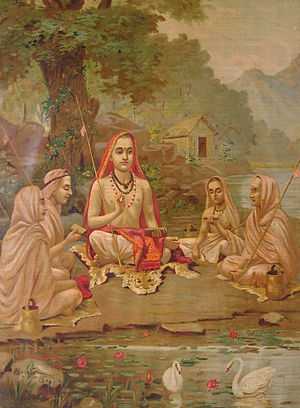
In a poetic work composed by Mahakavi Kalhan in the year 1148 CE, there is a mention of Sree Sharadad Devi temple and its geographic location. Kalhana mentions that in Lalitaditya's reign (8th century AD), some followers of a king of Gauda (Bengal), come to Kashmir under the pretence of visiting the shrine of Śāradā. The first verse of 'Prapanchsar' composed by Adi Shankaracharya is devoted to the praise of Sree Sharada Devi.
In the year 1030 CE, the Muslim historian Al-Baruni visited Kashmir. According to him, there was a wooden idol of Sree Sharada Devi in Sree Sharada Devi temple. He compared the temple of Sree Sharada Devi with the Multan Sun Temple, Vishnu Chakraswamin temple at Thaneshwar and Somnath temple.
During 16th century, when Akbar was ruling at Delhi, Abul Fazal, one of the famous 'Nava-Ratnas' in his Court, has written about Sree Sharada Devi temple that Sree Sharada Devi temple is near the banks of river Madhumati (currently Neelum river) which is full of gold particles and he also wrote that one can experience miracles on every eighth day of the bright fortnight of the month.
In the 14th century, the temple was attacked for the first time. After this attack, India started losing its contact with Krishanganga and Sharada Peeth. In the 19th century, Dogra king of Kashmir restored this temple.
Legends
Sage Shandilya used to meditate in Sharada-van. Near the temple of Sree Sharada Devi, there is 'Amarkund' lake. It is believed that Sage Shandilya got the 'darshan' of Sree Sharada Devi there.
Sharada script
Main article Śāradā script
Sharada script and Takri (from which Gurmukhi is derived) are originated here.
Visiting the temple
Kashmiri Pandits regularly try to visit this temple to offer prayers, but there are instances where they were not permitted to cross the LOC and visit the temple.[1]
Renovation
There is a demand from certain section of Indian politicians that Pakistan should renovate this temple, in the same manner that it renovated the Katasraj Temple in Punjab.[12]
Gallery
-

View of Sharda (Shardi) village from the inside of Sharada Peeth temple
-

Ruins of Sharada Peeth temple in Azad Kashmir
See also
Citations
- ↑ 1.0 1.1 1.2 1.3 "Pandits denied entry into temple in Azad Kashmir". The Hindu. 3 October 2007. Retrieved 2014-02-12.
- ↑ 2.0 2.1 "Pandits to visit Sharda temple". The Hindu. 17 May 2006. Retrieved 13 August 2012.
- ↑
- ↑ "Sharda Temple Photo Gallery by Gharib Hanif at". Pbase.com. Retrieved 2014-02-12.
- ↑ "National : Kashmiri Pandits want to visit Sharda Peeth in Azad Kashmir". The Hindu. 2005-02-27. Retrieved 2014-02-12.
- ↑ (Translator), F. Max Muller (June 1, 2004). The Upanishads, Vol I. Kessinger Publishing, LLC. ISBN 1419186418.
- ↑ (Translator), F. Max Muller (July 26, 2004). The Upanishads Part II: The Sacred Books of the East Part Fifteen. Kessinger Publishing, LLC. ISBN 1417930160.
- ↑ "Kottiyoor Devaswam Temple Administration Portal". Kottiyoordevaswom.com/. Retrieved 20 July 2013.
- ↑ Bansi Pandit (2008), p. 75.
- ↑ Pollock 2006, pp. 588–89
- ↑ 11.0 11.1 Chitkara (2002), p. 273.
- ↑ Zee, News (2 May 2007). "Pak should renovate Sharada Temple in Azad Kashmir: Advani". Zee News.com. Retrieved 13 August 2012.
References
- Pollock, Sheldon (2006). Language of the Gods in the World of Men. University of California Press..
- Chitkara, M.G. Kashmir Shaivism: Under Siege (2002 ed.). New Delhi: A.P.H.Publishing Corporation. ISBN 8176483605. Retrieved 13 August 2012.
- Pandit, Bansi. Explore Kashmiri Pandits (2008 ed.). USA: Dharma Publications. ISBN 0963479865. Retrieved 13 August 2012.
External links
| ||||||||||||||||||||||||||||||||